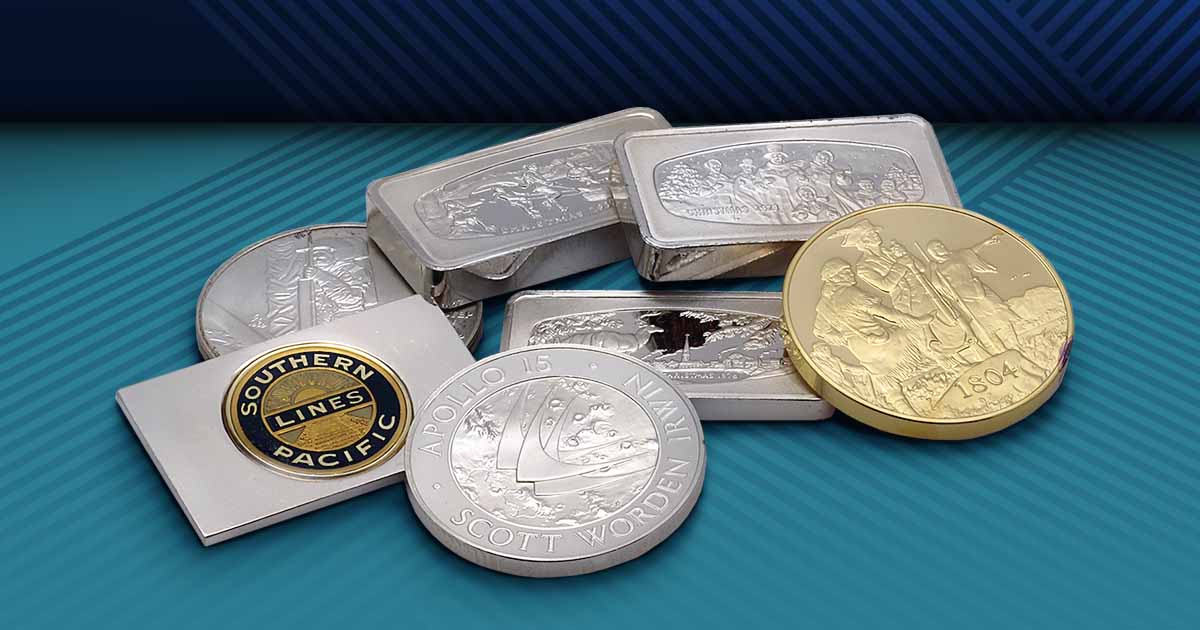
Stacking constitutional silver or coin silver is popular, but stacking sterling silver is less common. You can collect and stack sterling silver. When you compare sterling silver to coin silver by metal content, it might make more sense to collect sterling silver.
What is the Difference Between Sterling Silver and Constitutional Silver?
Sterling silver is a silver alloy made of 92.5% silver, and the balance of 7.5% is usually copper, although other metals may be used. While sterling silver is most often used in household applications like mirrors, flatware, and jewelry, you can buy sterling silver rounds and bars. However, since sterling silver bullion isn’t widely available, it can be difficult to accumulate.
Coin silver, or constitutional silver, depends on the year of issue and the coin type. It has a maximum millesimal fineness of 90% and a minimal fineness of 40%. Coin silver is easier to shop for since a much wider range of stackable products is available.
Why is Coin Silver More Popular than Sterling Silver?
One of the reasons coin silver is more popular among collectors than sterling silver could be that there is a centuries-old tradition of collecting coins and a community around it. Collecting coin silver has a robust history, and there are many unique pieces for collectors to gather.
Collectors may buy bags of coins from their local bank and sift through each roll, eagerly anticipating the thrill of finding silver among the cupro-nickel coins. Other collectors may purchase coin silver from a retailer, which costs more than buying coin rolls from the bank but takes less time, and there is guaranteed silver content.
While no one could contest the thrill of the hunt, there is always more precious metal content in sterling silver.
How Do I Know if My Sterling Silver is Real?
There are several ways of ensuring that the sterling silver you buy is authentic.
- Look for the hallmark. If sterling silver is authentic, it will possess one of the following:
- If the sterling was produced in the U.S., look for a stamp reading .925, S925, Ster, or Sterling.
- If the sterling silver is from France, look for a stamped vase or head of Minerva.
- If the sterling silver is from the United Kingdom, there should be a stamped lion or crowned harp.
- Use a magnet. Sterling silver is not magnetic. If your sterling silver is attracted to the magnet, it is not sterling silver.
- Tap the silver with a small object like a pencil. If it is authentic, there should be a high-pitched, resounding ring.
- Test the silver with ice. Since silver is phenomenal at transferring heat, it is fairly easy and straightforward to test this with ice.
- Lay a paper towel on a clean, dry surface.
- Place the silver item in question on the paper towel.
- Place one ice cube on the silver item and another ice cube elsewhere on the paper towel.
- Observe the rates at which the two ice cubes melt. If the silver is real, it will conduct the ambient temperature of your space to the ice cube, which will cause the ice cube to melt faster.
- If both ice cubes melt at the same rate, your item may not be genuine.
- If all else fails, take the item to a reputable jeweler or coin dealer, and ask what advanced testing options are available. They should be able to provide at least one authoritative analysis on the silver item.





